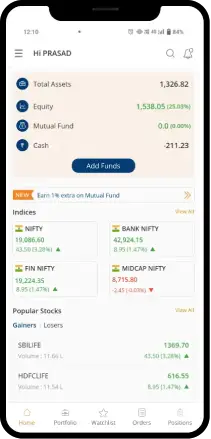- FAQs
- Share Market FAQs
Frequently Asked Questions on Share Market
The stock market, also known as the share market, is a common marketplace (usually known as the Stock Exchange) where the share units of publicly listed companies are issued and traded. It is here that investors can buy and sell shares of different companies, with the aim of booking better returns on investment than those offered on traditional investment instruments. The stock market is categorised into two types – the primary market where a formerly private company goes public for the first time with the launch of its Initial Public Offer (IPO) and the secondary market where shares of all listed companies are traded. Although it is known for its volatility, the stock market is also renowned for helping investors earn inflation-adjusted returns, provided they time their trades correctly and check the past performance and market cycles of securities before investing.
The share market is a place or platform where investors can buy, sell, or trade a wide range of market securities such as shares, bonds, derivative contracts like currencies and commodities, mutual funds, etc. The market is categorised into two types – the primary share market, where a company registers itself for the first time in order to raise funds from public investors by selling its shares through an Initial Public Offering (IPO) and then becomes a publicly-traded company. Then there is the secondary share market, where shares of already-listed companies are traded at their current price. Here, investors can buy and sell shares anytime and enter or exit the market as they please.
The basics of stock market investment you need to know to include the following
- You will need to open a DEMAT and Trading Account with a SEBI-recognised broker
- You must consider your risk profile, investment goals, and preferred investment tenures before you begin investing.
- You must familiarise yourself with the basic stock market jargon, the various exchanges, and trading platforms.
- You must review the costs associated with share market investments
- You must avoid putting all your eggs in one basket, and instead diversify your investments.
A combination of the words Sensitive and Index, the Sensex is the equity benchmark index of the Bombay Stock Exchange, comprising of the top 30 companies in terms of free-float market capitalisation from various sectors and trading on the BSE. In India, there are various Sensex indices, including the S&P Sensex Index, BSE Midcap and the BSE Bankex, among others.
Like the Sensex is to the BSE, the Nifty is the equity market index of the Indian National Stock Exchange (NSE). It combines the words National and Fifty and comprises the top 50 stocks in terms of free-float market capitalisation, from different sectors, and trading on the NSE. The prominent Nifty Indices in India include Nifty 50, Auto Nifty, Bank Nifty, Nifty IT, Nifty FMCG, etc.
The NSE and BSE are the two leading stock exchanges in India. NSE stands for the National Stock Exchange. It is the world's fourth-largest exchange based on its equity trading volume. It holds the distinction of being India's first stock exchange to offer screen-based trading. Then there is the Bombay Stock Exchange, or BSE, which holds the record of being Asia's first stock exchange. The BSE is regarded as the world's fastest stock exchange thanks to its trading speed of 6 microseconds per order.
The formula for investing in stocks for beginners is simple. Just follow these below-mentioned steps.
- Select a SEBI-approved and recognised stock brokerage platform to open your DEMAT and trading account – Mirae Asset, for instance.
- Provide the necessary documents (ID, address, and income proof) and complete the Know Your Customer (KYC) process.
- Login to your DEMAT account with the username and default password and change it to something strong. Memorise the password.
- Research about the stocks you wish to buy by considering your risk appetite, investment goals, and preferred investment duration. Also, assess the past performance of the stocks you choose across various market cycles to check how stably it has generated returns.
- Decide on the order quantity and optimise your investment portfolio with diversification to mitigate your investment risks.
In the share market, moving averages are technical indicators that investors and market analysts use to determine the direction of a trend. A moving average allows technical traders to generate various trading signals. Analysts use the moving averages to examine an asset's support and resistance ratios and evaluate its price movements. It helps them determine the potential price direction of an asset and trails the action price of the asset to demonstrate the direction of a given trend.
Share market volume indicators are essentially mathematical formulas, which are visually represented in the most commonly used charting platforms. Volume indicators can be of different types, and each indicator uses a marginally different formula. As a share trader, you should find the indicator that works best for your specific market approach, i.e., the method you use to determine the value of an asset after analysing the selling prices of similar assets. The three most common types of share market volume indicators include On-balance Volume (OBV) indicator, the Chaikin Money Flow indicator and the Klinger Oscillator indicator.
A share market breakout represents a share price moving outside of a defined support or resistance level at an increased volume. Breakout traders typically enter long positions after the share price breaks above the resistance level and enter short positions after the stick breaks below the support level.
A breakdown in stock market is basically the opposite of a breakout. It is a downward move in the price of a security, usually via an unidentified level of support, which signifies a further decline in the security price. Stock market breakdowns commonly occur on heavy volumes, and the resultant move lower tends to be relatively quick and severe in magnitude. Traders can identify stock market breakdowns using technical tools, live chart patterns, moving averages and trend lines.
Some of the most commonly used and important chart types in stock market include:
- Line chart
- Bar chart
- Point and figure chart
- Head and shoulder chart
- Renko Chart
- Single and multiple candlestick chart
In the share market, a candlestick is a kind of price chart used in the technical analysis of market prices. This chart displays the highs and lows and opening and closing prices of a given security for a particular period. Candlesticks echo the impact of investor sentiments on the prices of securities. Technical analysts generally use them to determine when to enter or exit trades.
Power your investments with our smart trading platforms

-
![app_download_icon_img]() 10 million+
10 million+
App downloads -
![1_Click_icon_img]() 1-Click
1-Click
Order Placement -
2,203 Crore+
Average Daily Turnover
For a powerful, stable and secure experience,
download m.Stock App & set up your lifetime Zero brokerage account @ one-time fee of ₹999
-
Scan QR code to download

- OR
-
Enter number to get app link
 +91
+91

Thank you for sharing your details with us!
Filing Complaints on Scores
Easy & Quick
- Register on SCORES portal https://scores.sebi.gov.in/
-
Mandatory details for filing complaints on SCORES
Name PAN Address Mobile Number E-mail ID -
Benefits:
Effective communication
Speedy redressal of the grievances
Terms & Conditions
- I understand that my account would be opened as per name appearing in Income Tax records and the same would be activated after all procedure relating to client due diligence in accordance with regulatory guidelines is completed.
- I authorize Mirae Asset Capital Markets (India) Private Limited (“MACM”) to contact me including but not restricted to call/sms and sending WhatsApp communication to me even though my mobile no. may be registered under DND/DNC Registry.
- I authorize MACM to undertake my KYC online through KRA/Aadhaar/Digi locker based on authentication of opening Trading and Demat account with MACM.
- The account opening charges once paid will not be refunded under any circumstances. Client need to complete his/her account opening journey within six months from date of the payment. In case the client resumes his/her account opening journey after six months from date of payment, it will be considered as fresh/new application and he/she will have to again pay the account opening charges prevalent at the time of fresh/new application.
- I understand that Investment in securities markets are subject to marketrisks, please read all the related documents carefully before investing. Brokerage will not exceed the SEBI prescribed limits.
- I confirm having read/been explained and understood the contents of the document of Policy and Procedures of the Stock broker and the tariff sheet. I further confirm having read and understood the contents of the Rights and Obligations document, Risk Disclosure Document, Guidance Note, Additional Terms & Conditions & Tariff Sheet for Trading and Demat. I do hereby agree to be bound by such provisions as outlined in these documents. I have also been informed that the standard set of documents has been displayed for information on website www.mstock.com.The Rules & Regulations of the Depository and Depository Participant, pertaining to an account which is in force now, have been read by me/us and I/We have understood the same and I agree to abide by and to be bound by the rules as are in force from time to time for such account. You can view/download the same by clicking https://bit.ly/3CPMZ5k

